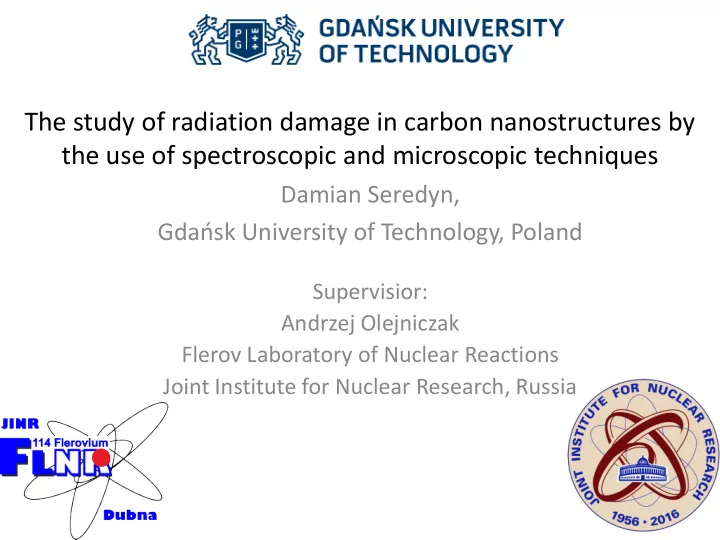

The study of radiation damage in carbon nanostructures by the use of spectroscopic and microscopic techniques Damian Seredyn, Gdańsk University of Technology, Poland Supervisior: Andrzej Olejniczak Flerov Laboratory of Nuclear Reactions Joint Institute for Nuclear Research, Russia
A purpose of my project was to investigate radiation damage created in carbon structures by high-energy ions using Raman spectroscopy. Cyclotron: IC-100 Ions: Xe +23 /Xe +24 Raman spectrometer: Source: https://www.chemiestun.de/pse/daten.php?oz=54 NTEGRA Spectra Carbon structures: - HOPG - Graphene - Graphene Oxide (GO) Fig. 1: HOPG structure observed by STM 2 microscope
Cyclotron IC-100 two-plane beam scan system installed in the extracted beam transporation line Ion energy : 0.9 ÷1.1 MeV/nucl Fig. 2: Photos of cyclotron IC-100 in Flerov Laboratory JINR [1]
Raman spectrometer NTEGRA Spectra made by NT-MDT Integration of SPM and Raman scattering spectroscopy Interdisciplinary research at the nanometer scale: AFM (STM) + Confocal Raman + SNOM + TERS Laser: 473 nm Fig. 3: Photos of Raman spectrometer localized at FLNR Fig. 4: Jabłoński diagra� for Rayleigh a�d Raman scattering [2]
Carbon structures Highly Oriented Pyrolytic Graphite (HOPG) Graphene Oxide (GO) Fig. 7: SEM photo of graphene oxide structure [5] Fig. 5: HOPG structure observed by STM and positional relationship between two identical graphene planes [3] a) b) Graphene Fig. 8: a) Raman spectra of graphene [6], b) comparision between graphene Fig. 6: Example of graphene structure observed by STM [4] and graphite Raman spectra [7]
80 60 Intensity (a.u.) 40 Direct impact model 20 Results: HOPG 0 -20 -40 1500 HOPG Raman Shift (cm -1 ) 2460 nonradiated 0,5 1640 A D /A G = a(1-e -b ) 820 0 0,4 840 12 Xe + /cm 2 2*10 560 280 0,3 0 A D /A G 2760 12 Xe + /cm 2 6*10 1840 0,2 920 Intensity (a.u.) 0 0,1 2220 13 Xe + /cm 2 10 1480 740 0,0 0 1830 13 Xe + /cm 2 2*10 1220 0 2 6 10 20 60 65 610 12 Xe + /cm 2 10 0 Fig. 10: Area ratio of peaks D to G versus Xe + ion doses 2340 13 Xe + /cm 2 6*10 1560 780 0 1680 13 Xe + /cm 2 6,5*10 1120 Table 2: Calculated values of crystallite dimensions for HOPG 560 0 0 1000 2000 3000 4000 -1 ) Raman Shift (cm Fig. 9: Evolution of Raman Spectra for HOPG irradiated with various Xe + ion doses
Results: Graphene Fig. 12: Photo of investigated area on the sample Fig. 11: Map of area ratio of peaks 2D to G 2400 Single layer graphene 2000 Bilayer graphene 2200 1800 2000 Intensity (a.u.) Intensity (a.u.) 1800 1600 1600 1400 1400 1200 1200 1000 1000 1000 1500 2000 2500 3000 3500 4000 1000 1500 2000 2500 3000 3500 4000 -1 ) Raman Shift (cm -1 ) Raman Shift (cm Fig. 13: Histogram of area ratio peaks 2D to G Fig. 14: Examples of obtained Raman spectra for investigated graphene
Results: Graphene Oxide 70000 35000 12 Xe + /cm 2 12 Xe + /cm 2 60000 10 30000 6*10 50000 25000 Intensity (a.u.) Intensity (a.u.) 40000 20000 30000 15000 20000 10000 10000 5000 0 0 -10000 -5000 0 500 1000 1500 2000 2500 3000 3500 0 500 1000 1500 2000 2500 3000 3500 -1 ) -1 ) Raman Shift (cm Raman Shift (cm Fig. 15: Raman spectra for GO irradiated with 10 12 Xe + /cm 2 Fig. 16: Raman spectra for GO irradiated with 6*10 12 Xe + /cm 2 60000 13 Xe + /cm 2 10 50000 Table 3: Calculated values of area ratio peaks sp1 to D_G 40000 Intensity (a.u.) 30000 20000 10000 0 -10000 0 500 1000 1500 2000 2500 3000 3500 -1 ) Raman Shift (cm Fig. 17: Raman spectra for GO irradiated with 10 13 Xe + /cm 2
Summary Raman spectroscopy is powerful tool for investigation carbon structures Controlled method of creating defects in investigated material Further investigation
Thanks for your attention!
Bibliography [1] http://flerovlab.jinr.ru/flnr/ic-100.html [18.07.2016]; [2] http://bwtek.com/raman-theory-of-raman-scattering/ [19.07.2016]; [3] http://www.spmtips.com/test-structures-HOPG.html [19.07.2016]; [4] http://www.sic.cas.cn/xwzx/kjxx/201405/t20140516_4121173.html [19.07.2016]; [5] https://graphene-supermarket.com/High-Surface-Area-Reduced-Graphene- Oxide.html [19.07.2016]; [6] K. Grodecki, Spectroskopia ramanowska grafenu, Electronic Materials, T. 41, 1/2013; [7] R. Saito et al., Raman spectroscopy of graphene and carbon nanotubes , Advances in Phisics, Vol. 60, no.3, 2011; [8] S. Mikhailov, Physics and Applications of Graphene – Experiments , 2011, ISBN 978-953-307-217-3, p. 439-454;
Recommend
More recommend